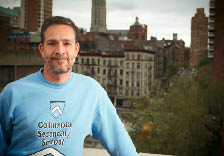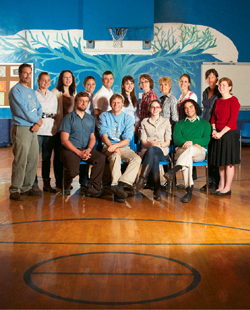Building a School to Change Lives
Columbia Secondary School's principal, Jose Maldonado, is planting seeds for the future.
A group of 15 sixth graders—most of them holding their noses—scurry through the halls of Columbia Secondary School.
“It’s following us!” one shouts in reference to the odor of shellfish gone bad, the result of an accidentally unplugged refrigerator, which, unfortunately, had been storing an array of specimens intended for dissection in the sixth graders after-school science lab.
Before chaos ensues, Jose Maldonado, the school’s principal and also, at this particular moment, its after-school instructor, ushers the group onto the roof to conduct class as usual. Soon students are settled on benches, listening to two of their number present findings on the visual systems of crustaceans. Crisis averted.
Since CSS opened its doors nearly three years ago under his leadership, Maldonado, like most public school principals, has served as a “fundraiser, cheerleader and rainmaker.” Yet he also seems to be involved at almost every level of the school, from talking to parents at almost at any time of the day (they have his cell phone number and are encouraged to use it) to taking groups of students to his native Puerto Rico as part of the school’s unique “J-term”—a separate mini-semester in June when the whole school heads off on extended field study trips in locations that range from Maine to the parks of New York City.
“It’s imperative for the principal to be an instructional leader,” says Maldonado, who received his Ph.D. in Science Education from TC and still teaches a course at the College each semester.
A partnership between the New York City Department of Education, the community, and Columbia University, CSS, located on 123rd Street between Amsterdam and Morningside Avenues, serves high-achieving, mostly low-income students from a catchment zone that is primarily in West Harlem.
It combines the curricular richness of an elite private school (Maldonado ran one in Puerto Rico before taking on his current assignment) with the idealism of public education. With a special focus on math, science and technology, the school—which currently numbers about 280 students in the sixth, seventh and eighth grades; next year, as its inaugural class moves into the ninth grade, it will begin functioning as a high school—offers classes in more than 60 subjects, including such non-standard fare as genetics, philosophy, engineering, robotics and outdoor survival. The faculty (whom students address as “professor”) are mostly young and all highly accomplished (and, in some cases, widely published). Students are assigned, for the duration of their time at the school, into themed “houses,” named for the scientist Marie Curie, the environmentalist Rachel Carson, the architect Antoni Gaudí, and other innovative thinkers. And the emphasis is on high expectations and the study of big ideas: to develop students’ inquiry and argumentation skills, the school also features a series of courses designed and led by Deanna Kuhn, Professor of Education and Psychology, who was Maldonado’s advisor while he was earning his degree at TC.
In three short years, CSS has established itself as one of the most rigorous and high-performing schools in the city. The President of the Dominican Republic personally visited the school and is now working with Maldonado and Kuhn to replicate its methods in a new model school in his own country. Maldonado is proud, but his ultimate goal extends far beyond putting up impressive numbers.
“Chances like this don’t come around very often,” he says of his decision to head CSS. “My goal is to leave behind a great public school, one that will be changing the lives of children for years to come”—a goal that can only be realized by an intense focus on students, day in and day out.
Back on the roof, discussion among the sixth graders turns to how an organism’s brain can process images from different sources.
“What a great question,” Maldonado says. “This is a wonderful area for you to think about when you’re doing your
Ph.D.’s in science research.”
Published Wednesday, May. 19, 2010

